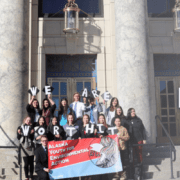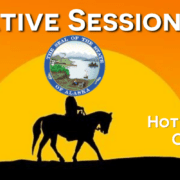The old vintage rock band is back together in the House
This week, an old pattern emerged in the State House – a Republican majority created through the addition of the Bush Caucus Democrats and Independents. News broke Wednesday morning that the razor thin Republican majority conference appeared to coalesce. Western and Northern AK Dems agreed to help make what appears to be at least a 23-member majority. This structure has been in place for most of the legislatures since the early 1980s, since the famous legislative coup in the 12th State Legislature. Such longevity makes one marvel at how unique the majority Democratic Tri-Partisan (Democrat, Republican, and Independent) body that ran the House between the 30th and 33rd legislatures was.
The rise of the oil industry in Alaska created Republican rule, and the decline of the oil industry is making way for dynamic political arrangements. This is an oversimplification and is mostly true.
The formation of a Republican/Bush Caucus majority in the House doesn’t represent a solid return to the played-out extractive narrative, just a pit-stop on the way to the future. For reassurance, one just has to look over to the state Senate where a massive 17-member Bipartisan Majority has formed thanks to the Ranked Choice Voting citizens initiative that tossed a hand grenade into party-run primaries and opened the door for more moderate candidates. While the Governor now has an ally in the House, the Senate will be a formidable backstop against anything too wacky. And who knows, the House Majority will see the wisdom in focusing on the same items as the Senate has chosen to rally around: decreasing high energy and healthcare costs, improving teacher and public employee retention, and providing adequate education funding. It is not a radical agenda by any means.
Early statements by the apparent Speaker-Elect, Cathy Tilton, hint at a willingness to dust off the report of the Bipartisan Fiscal Policy Working Group. Some fairly far-out players on the right flank could easily blow up any policy effort deemed too moderate or progressive. The Democratic Caucus left outside the majority are now free to loudly oppose weak-sauce fiscal efforts. The House will need steady communication with the Senate and strong leadership if they are going to make headway on fiscal issues.
The Governor will have an outsized influence on the House leadership, and what this wild-card Governor wants to do is anyone’s guess. It could be he wants to provide unrealistic permanent fund dividends; it could be he wants to have the permanent fund invested into boondoggle projects in Alaska, like a natural gas line. We just don’t know. A second term gives him some breathing room from future elections – unless he is planning for a run for U.S. Senate sometime. Either way, he has four years to think about it and about his “legacy,” for what that’s worth. Without a mega-project or a spiffy new building as a reminder of his greatness through the ages, a decaying fleet of Marine Highway ferries and a considerably declined state population might be the relics of his rule.
We hope that this is the year everyone decides to work on a few things together and does them well enough with the tools at hand. It is not asking for a lot. Let’s think practical and hope big. Baby steps, Alaska!
Stay tuned,
The Alaska Center









